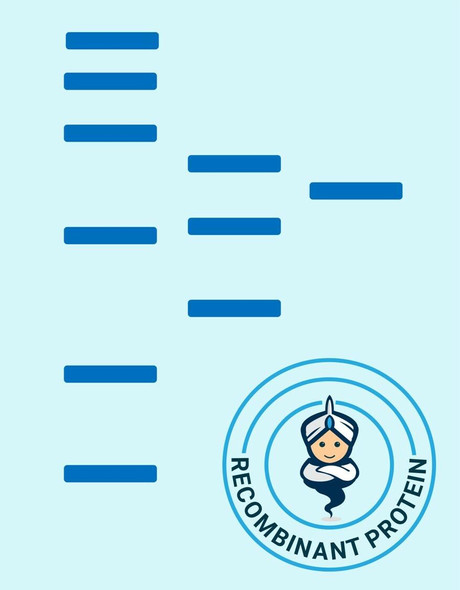Human PRDX3 Recombinant Protein (RPPB2179)
- SKU:
- RPPB2179
- Product type:
- Recombinant Protein
- Size:
- 20ug
- Species:
- Human
- Target:
- PRDX3
- Synonyms:
- AOP1
- MER5
- AOP-1
- SP-22
- Source:
- Escherichia Coli
- Uniprot:
- P30048
Description
| Product Name: | Human PRDX3 Recombinant Protein |
| Product Code: | RPPB2179 |
| Size: | 20µg |
| Species: | Human |
| Target: | PRDX3 |
| Synonyms: | AOP1, MER5, AOP-1, SP-22, PRO1748, MGC24293, MGC104387, PRDX3, Thioredoxin-dependent peroxide reductase mitochondrial, Peroxiredoxin-3, PRX III, Antioxidant protein 1, Protein MER5 homolog, HBC189. |
| Source: | Escherichia Coli |
| Physical Appearance: | Sterile Filtered colorless solution. |
| Formulation: | The PRDX3 solution contains 20mM Tris-HCl pH-8, & 10% glycerol. |
| Stability: | Store at 4°C if entire vial will be used within 2-4 weeks. Store, frozen at -20°C for longer periods of time. For long term storage it is recommended to add a carrier protein (0.1% HSA or BSA).Avoid multiple freeze-thaw cycles. |
| Purity: | Greater than 95.0% as determined by SDS-PAGE. |
| Amino Acid Sequence: | MPAVTQHAPY FKGTAVVNGE FKDLSLDDFK GKYLVLFFYP LDFTFVCPTE IVAFSDKANE FHDVNCEVVA VSVDSHFSHL AWINTPRKNG GLGHMNIALL SDLTKQISRD YGVLLEGSGL ALRGLFIIDP NGVIKHLSVN DLPVGRSVEE TLRLVKAFQY VETHGEVCPA NWTPDSPTIK PSPAASKEYF QKVNQ |
| Biological Activity: | The specific activity was found to be approximately 82-83 pmole/min/µg.The enzymatic activity was confirmed by measuring the remaining peroxide after incubation of PRDX3 and peroxide for 20 min at room temperature. Specific activity is defined as the amount of hydroperoxide that 1ug of enzyme can reduce at 25°C for 1 minute. |
PRDX3 is part of the peroxiredoxin family of antioxidant enzymes, that reduces hydrogen peroxide and alkyl hydroperoxides. PRDX3 is particularly located in the mitochondria and involved in the regulation of cellular redox status by serving as a primary line of defense against H2O2 produced during respiration. PRDX3 is a significant regulator of the abundance of mitochondrial H(2)O(2), which itself promotes apoptosis in cooperation with other mediators of apoptotic signaling. PRDX3 mitochondrial protein is significantly decreased in Alzheimer Disease and Down Syndrome.
PRDX3 Human Recombinant produced in E.Coli is a single, non-glycosylated, polypeptide chain containing 195 amino acids (63-256 a.a.) and having a molecular mass of 21.5 kDa.The PRDX3 is purified by proprietary chromatographic techniques.
| UniProt Protein Function: | PRDX3: Involved in redox regulation of the cell. Protects radical-sensitive enzymes from oxidative damage by a radical- generating system. Acts synergistically with MAP3K13 to regulate the activation of NF-kappa-B in the cytosol. Belongs to the AhpC/TSA family. |
| UniProt Protein Details: | Protein type:Oxidoreductase; EC 1.11.1.15 Chromosomal Location of Human Ortholog: 10q25-q26 Cellular Component: mitochondrion; mitochondrial matrix; cytoplasm; early endosome; IkappaB kinase complex; cytosol Molecular Function:protein C-terminus binding; identical protein binding; protein binding; thioredoxin peroxidase activity; caspase inhibitor activity; alkyl hydroperoxide reductase activity; kinase binding; protein kinase binding Biological Process: negative regulation of kinase activity; mitochondrion organization and biogenesis; response to lipopolysaccharide; negative regulation of caspase activity; activation of NF-kappaB transcription factor; response to reactive oxygen species; peptidyl-cysteine oxidation; response to hydrogen peroxide; regulation of mitochondrial membrane potential; hydrogen peroxide catabolic process; positive regulation of cell proliferation; myeloid cell differentiation; response to oxidative stress; negative regulation of apoptosis; maternal placenta development |
| NCBI Summary: | This gene encodes a mitochondrial protein with antioxidant function. The protein is similar to the C22 subunit of Salmonella typhimurium alkylhydroperoxide reductase, and it can rescue bacterial resistance to alkylhydroperoxide in E. coli that lack the C22 subunit. The human and mouse genes are highly conserved, and they map to the regions syntenic between mouse and human chromosomes. Sequence comparisons with recently cloned mammalian homologs suggest that these genes consist of a family that is responsible for the regulation of cellular proliferation, differentiation and antioxidant functions. This family member can protect cells from oxidative stress, and it can promote cell survival in prostate cancer. Alternative splicing of this gene results in multiple transcript variants. Related pseudogenes have been identified on chromosomes 1, 3, 13 and 22. [provided by RefSeq, Oct 2014] |
| UniProt Code: | P30048 |
| NCBI GenInfo Identifier: | 2507171 |
| NCBI Gene ID: | 10935 |
| NCBI Accession: | P30048.3 |
| UniProt Related Accession: | P30048 |
| Molecular Weight: | 26kDa |
| NCBI Full Name: | Thioredoxin-dependent peroxide reductase, mitochondrial |
| NCBI Synonym Full Names: | peroxiredoxin 3 |
| NCBI Official Symbol: | PRDX3 |
| NCBI Official Synonym Symbols: | AOP1; MER5; AOP-1; SP-22; HBC189; PRO1748; prx-III |
| NCBI Protein Information: | thioredoxin-dependent peroxide reductase, mitochondrial |
| UniProt Protein Name: | Thioredoxin-dependent peroxide reductase, mitochondrial |
| UniProt Synonym Protein Names: | Antioxidant protein 1; AOP-1; HBC189; Peroxiredoxin III; Prx-III; Peroxiredoxin-3; Protein MER5 homolog |
| UniProt Gene Name: | PRDX3 |
| UniProt Entry Name: | PRDX3_HUMAN |










